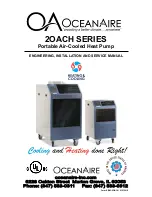
Page 23
Installer’s Guide
Does the unit run and operate as described in the section on
Sequence of Operation on page 24 in response to the room
thermostat?
Are the condenser fan and indoor blower operating correctly
with proper rotation and without undue noise?
Is the compressor operating correctly and has the system been
checked with a charging chart?
Has the voltage and running current been checked to deter
mine if it is within limits?
Has the thermostat been checked for calibration and the air
discharge grilles adjusted to balance the system?
Has the ductwork been checked for air leaks and
condensation?
Has the furnace manifold pressure been checked and
adjusted if necessary?
Has the heating air temperature rise been checked?
Has the unit been checked for tubing and sheet metal rattles?
Are there any other unusual noises to be checked?
Are all covers and panels in place and properly fastened?
Has the owner been instructed on the proper operation and
maintenance of the unit? Be sure to leave this manual with the
owner.
Final Installation Checklist
1. Check to make sure all grilles and registers are open and all
unit access doors are closed before start-up.
2. Purge the gas supply line of air by opening the union ahead of
the unit. When the odor of gas is detected, retighten the union
and wait five (5) minutes before proceeding.
3. Set the comfort control to its lowest position and the fan to
AUTO or ON.
4. Open the main gas valve(s) and turn on the unit power supply.
5. Reset the heating temperature of the comfort control to the
highest value above room temperature. The combustion blower
motor should energize. The main burners should light within
20-25 seconds. Initial start may be delayed somewhat if the
unit has not been purged and air is trapped in the gas line.
NOTE:
Blue smoke produced by the heat exchanger during the
initial burner firing is caused by a thin film of oil on the surface
of the heat exchanger. This oil will burn off quickly.
Summary of Contents for 4YCY4024
Page 5: ...Page 5 Installer s Guide Figure 2 4YCY4024 through 4YCY4036 2 of 3...
Page 6: ...Page 6 Installer s Guide Figure 3 4YCY4024 through 4YCY4036 3 of 3...
Page 8: ...Page 8 Installer s Guide Figure 5 4YCY4042 through 4YCY4060 2 of 3...
Page 9: ...Page 9 Installer s Guide Figure 6 4YCY4042 through 4YCY4060 3 of 3...






































